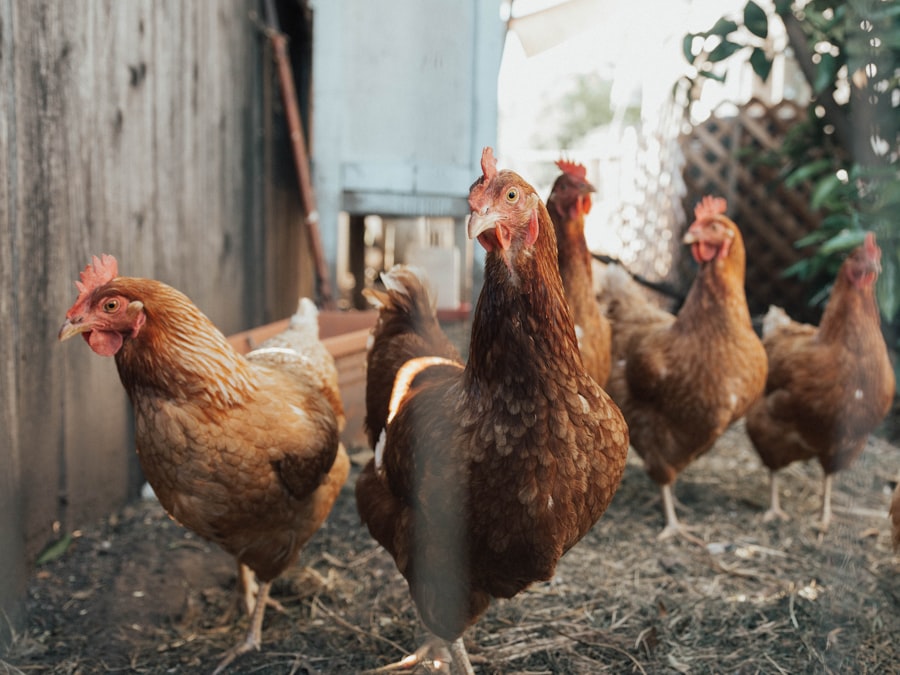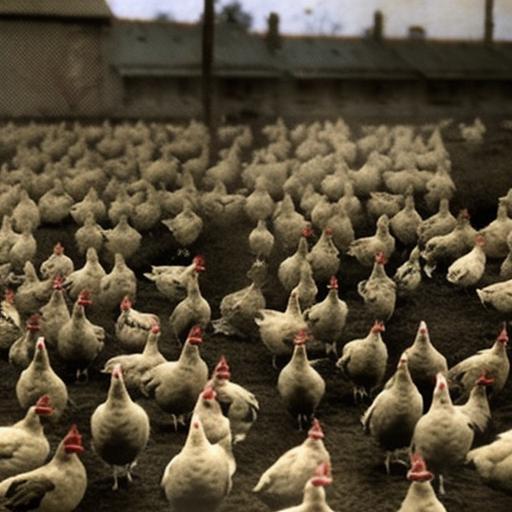During World War II, food production and rationing became a critical issue for many countries involved in the conflict. With resources being diverted to the war effort, there was a significant impact on the availability of food for civilians. Rationing was implemented to ensure that everyone had access to essential items, but it also meant that families had to find alternative ways to supplement their diets. One solution that many families turned to was keeping chickens in their backyards. This article will explore the importance of keeping chickens during WWII and how it helped alleviate food shortages.
Key Takeaways
- Keeping chickens during WWII was important for food production due to rationing and food shortages.
- Building a chicken coop in your backyard is a great way to start keeping chickens.
- Choosing the right breeds of chickens is important for your specific needs.
- Feeding and caring for your chickens during the war required resourcefulness and creativity.
- Backyard chicken keeping during WWII had a lasting legacy and government programs encouraged it.
Rationing and Food Shortages During the War
Rationing was a system implemented by governments during WWII to ensure that essential goods were distributed fairly among the population. Items such as meat, sugar, butter, and eggs were limited and individuals were given ration books with coupons that allowed them to purchase a certain amount of each item per week. This system was necessary due to the scarcity of resources caused by the war.
The impact of food shortages on families and communities was significant. Many people struggled to feed themselves and their families, and malnutrition became a real concern. The limited availability of certain foods meant that people had to find creative ways to stretch their rations and make do with what they had. Keeping chickens provided a reliable source of protein and helped supplement the limited food supply.
The Benefits of Keeping Chickens for Food Production
Keeping chickens during times of food scarcity provided several benefits. Firstly, chickens are a source of fresh eggs, which are highly nutritious and versatile in cooking and baking. Eggs are an excellent source of protein, vitamins, and minerals, making them an essential part of a balanced diet. Having fresh eggs readily available meant that families could rely on this source of nutrition even when other foods were scarce.
In addition to eggs, chickens also provide meat. While not as common as eggs, chickens can be raised for meat when necessary. This meant that families could have a source of fresh meat without relying on the limited supply available through rationing. Chickens are relatively easy to raise and can be kept in small spaces, making them an ideal choice for backyard food production.
How to Build a Chicken Coop for Your Backyard
Building a chicken coop in your backyard is a relatively simple process that can be done with basic tools and materials. Here is a step-by-step guide to help you get started:
1. Choose the right location: Find a spot in your backyard that is well-drained and receives plenty of sunlight. Make sure it is away from any potential predators.
2. Gather materials: You will need wood, wire mesh, nails, screws, and hinges. The size of the coop will depend on how many chickens you plan to keep.
3. Build the frame: Start by building the frame of the coop using the wood. Make sure it is sturdy and secure.
4. Add the walls and roof: Attach the walls and roof to the frame using nails or screws. Make sure there are no gaps where predators can enter.
5. Install the wire mesh: Cover the windows and openings with wire mesh to keep out predators while still allowing for ventilation.
6. Add nesting boxes and perches: Install nesting boxes for the chickens to lay their eggs and perches for them to roost on.
7. Provide food and water: Set up a feeder and waterer inside the coop to ensure that your chickens have access to food and water at all times.
Choosing the Right Breeds of Chickens for Your Needs
When choosing breeds of chickens for your backyard, it’s important to consider your specific needs and circumstances. Different breeds have different characteristics that make them more suitable for certain purposes. Here are some factors to consider when choosing the right breed:
1. Egg production: If your main goal is to have a reliable source of eggs, then you should choose breeds that are known for their high egg production. Breeds such as Leghorns and Rhode Island Reds are excellent choices for egg-laying.
2. Meat production: If you are interested in raising chickens for meat, then you should choose breeds that are known for their meat quality. Breeds such as Cornish Cross and Plymouth Rock are popular choices for meat production.
3. Dual-purpose breeds: Some breeds are known for their ability to produce both eggs and meat. These breeds are a good option if you want to have a versatile flock that can provide both eggs and meat when needed. Examples of dual-purpose breeds include Sussex and Wyandotte.
4. Temperament: Consider the temperament of the breed when choosing chickens for your backyard. Some breeds are more docile and friendly, while others can be more aggressive or flighty. Choose a breed that suits your preferences and the environment in which they will be kept.
Feeding and Caring for Your Chickens During the War

Feeding and caring for chickens during times of food scarcity requires careful planning and resourcefulness. Here are some tips to help you keep your chickens healthy and productive:
1. Rationing feed: Just like humans, chickens may need to have their feed rationed during times of scarcity. Make sure to provide them with enough feed to meet their nutritional needs, but avoid overfeeding to conserve resources.
2. Supplementing with kitchen scraps: During times of food scarcity, it’s important to make use of all available resources. Kitchen scraps such as vegetable peels, leftover grains, and bread can be fed to chickens as a supplement to their regular feed.
3. Foraging: Allow your chickens to forage in your backyard if possible. They will eat insects, worms, and grass, which can help supplement their diet and reduce the amount of feed they require.
4. Water supply: Make sure your chickens have access to clean and fresh water at all times. Water is essential for their health and egg production.
5. Health care: Regularly check your chickens for signs of illness or parasites. Treat any issues promptly to prevent the spread of disease and ensure the health of your flock.
Collecting and Using Chicken Eggs for Cooking and Baking
Collecting eggs from your backyard chickens is a rewarding experience that provides you with a fresh and nutritious ingredient for cooking and baking. Here are some tips for collecting and using chicken eggs:
1. Collect eggs daily: Make it a habit to collect eggs from the nesting boxes every day. This ensures that the eggs are fresh and reduces the risk of them being damaged or broken.
2. Store eggs properly: Eggs should be stored in a cool and dry place, preferably in a refrigerator. This helps to preserve their freshness and extends their shelf life.
3. Use eggs in cooking: Eggs are a versatile ingredient that can be used in a wide variety of dishes, from omelets and quiches to cakes and cookies. Experiment with different recipes to make the most of your fresh eggs.
4. Preserve eggs: If you have an excess of eggs, you can preserve them by pickling or canning. This allows you to enjoy them later when fresh eggs may not be readily available.
Selling or Trading Excess Eggs and Chickens for Other Goods
During times of scarcity, excess eggs and chickens can be valuable commodities that can be used for bartering and trading. If you have more eggs or chickens than you need, consider selling or trading them for other goods that you may require. This can help create a sense of community cooperation and ensure that everyone has access to essential items.
Government Programs to Encourage Backyard Chicken Keeping
During WWII, governments implemented programs to encourage backyard chicken keeping as a way to alleviate food shortages. These programs provided resources and support to individuals and communities interested in raising chickens. They offered guidance on building coops, selecting breeds, and caring for chickens. By promoting backyard chicken keeping, governments were able to increase food production at the local level and reduce the strain on the rationing system.
Legacy of Backyard Chicken Keeping During WWII and Beyond
The practice of keeping chickens in backyards during WWII had a lasting impact on communities and individuals. It provided a source of food and nutrition during times of scarcity and helped alleviate the strain on the rationing system. This practice has continued to be popular in modern times, with many people choosing to keep chickens in their backyards for various reasons, including sustainability, self-sufficiency, and a desire for fresh and nutritious food. The legacy of backyard chicken keeping during WWII serves as a reminder of the resilience and resourcefulness of individuals and communities during times of hardship.
During World War II, keeping chickens became a popular practice due to food rationing and shortages. If you’re interested in learning more about how to keep chickens during this time, check out this informative article on poultrywizard.com. It provides detailed plans for building a chicken coop and run, ensuring that your feathered friends have a safe and comfortable space. Additionally, if you’re concerned about keeping your chickens warm during the colder months, this article offers insights on using heaters in chicken coops. Lastly, if you’re looking for tips on how to easily move your chicken coop from one location to another, this article has got you covered. Happy chicken keeping!
FAQs
What was the purpose of keeping chickens during WW2?
Keeping chickens during WW2 was encouraged as a way to supplement food rations and provide a source of fresh eggs and meat for families.
How did people acquire chickens during WW2?
People could acquire chickens through various means such as purchasing them from local farmers, trading goods or services for them, or receiving them as gifts from friends or family members.
Were there any restrictions on keeping chickens during WW2?
There were some restrictions on keeping chickens during WW2, such as the number of chickens allowed per household and regulations on the size and placement of chicken coops.
What were the benefits of keeping chickens during WW2?
Keeping chickens during WW2 provided families with a source of fresh eggs and meat, which were often scarce due to rationing. Chickens also helped to control pests and provided fertilizer for gardens.
Did keeping chickens require a lot of resources?
Keeping chickens did not require a lot of resources, as they could be fed with scraps and kitchen waste. However, they did require a clean and secure coop and regular care and attention.
Did keeping chickens become popular after WW2?
Keeping chickens remained popular after WW2, particularly among those who valued self-sufficiency and sustainable living. Today, backyard chicken keeping is a popular hobby and a way to provide fresh, organic eggs and meat.
Meet Walter, the feathered-friend fanatic of Florida! Nestled in the sunshine state, Walter struts through life with his feathered companions, clucking his way to happiness. With a coop that’s fancier than a five-star hotel, he’s the Don Juan of the chicken world. When he’s not teaching his hens to do the cha-cha, you’ll find him in a heated debate with his prized rooster, Sir Clucks-a-Lot. Walter’s poultry passion is no yolk; he’s the sunny-side-up guy you never knew you needed in your flock of friends!







